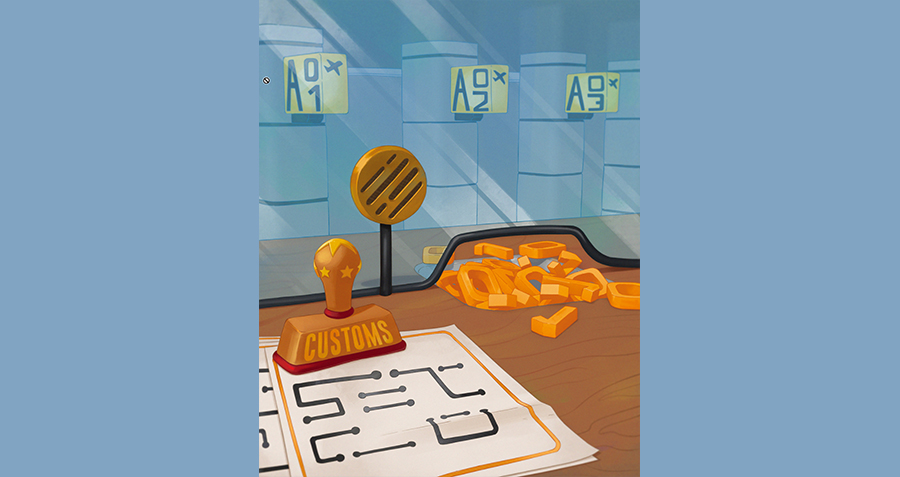Will this hybrid airship one day provide disaster relief and fill in logistics niches? Hybrid Air Vehicles CEO Stephen McGlennan is betting on it.
Airlander 10, part plane and part airship, is the world’s longest aircraft in operation today. It is roughly the size of a football field but its shape is different to any airship of decades past.
Developed by British manufacturer Hybrid Air Vehicles (HAV), the Airlander 10 boasts the ability to ascend from anywhere with no need for an airport or runway, while also maintaining the capacity to transport a large amount of goods. Its use of helium also makes it environmentally friendly and resistant to fire. Government and logistics companies will find it useful in providing humanitarian aid or product transportation.
Yet despite these advantages, the Airlander has not been put into real practice. The Airlander 10 hit the ground during a test flight in August this year and it is ready to take another in the coming Spring. According to Stephen McGlennan, CEO of HAV since September 2013, over 100 million pounds has been invested in the project. He says that the project will take a number of years to complete, but he believes that patience will pay off.
Q. We know that the Airlander project was first developed by the US government for surveillance purposes and your company later purchased it. What prompted you to take over and continue this project?
A. Well, we’ve been doing this for 20 years now, and the American project is very useful and it was just three years. So we always make a distinction between the intellectual property, which we always owned, and the big physical aircraft that was 92 meters in length, which was owned by the US army and we bought that back. The key thing is to develop this new form of aircraft for the world. And because it’s new, we need one to show people what it can do. That’s why we bought it back.
Q. We noticed the appearance for the aircraft is unique, what are the technical reasons behind this design?
A. It’s a wing. It’s a lifting body. So think of the American B-2 bomber aircraft or the space shuttle, these aircraft are also in a wing shape. And that enables it, when the engines are switched on, to receive lift. That’s the special shape of the Airlander. But the Airlander is also quite large and round, because inside it is filled with gas. And that gas is helium, a lifting gas. So for every cubic meter of helium, we can lift one kilogram. And that force gives us huge efficiency and let us do things other aircraft can’t do.
Q. So helium is the key to how it ascends and descends?
A. Yes, it’s a key distinguishing factor. So think of a really modern aircraft, with carbon fiber, with fiber optics, with the best computers, so like a 787—our aircraft has that level of technology and it also has helium, and what the helium does is give extra lift, which makes it efficient. We use far less fuel, only a third of the fuel used by a normal aircraft. That makes the aircraft cheap to run, but also really environmentally friendly.
Q. What kind of fuel do you use?
A. So presently we just use normal aviation fuel, we do have some work ongoing with German companies, and I think also in the future with Chinese companies, to use electric motors. And then we will have batteries and solar power, and that gives us the opportunity to have zero emissions, silent, large aircraft. And that will be a fantastic thing.
Q. Is it very expensive to build an Airlander?
A. It’s about the same as a big helicopter. So if you think of a Sikorsky helicopter, or a Chinook, it’s about the same as that. We have some discussions ongoing with prospective partners in China, and they think they can help us be even more efficient. We’re very excited about that.
Q. So the cost is probably the same and the energy you use is one third.
A. Yeah, so the operating cost is very low. Our operating cost can be as low as one tenth of an aircraft of a similar capacity. So we then have the chance to really change what people use this aircraft for.
Q. The Airlander 10 is said to have many different functions, what are the main functions?
A. The main function is ability to fly from anywhere to anywhere. No need for a runway, no need for any infrastructure. So that means, if you have a problem, say a humanitarian crisis in a remote part of the country. Then the aircraft can go right to the point of need, with the cargo, the people and services in need. In the future, things like a remote mine, so if you’re going to mine which is creating gold or platinum or one of the rare earth minerals, but it’s 500 kilometers away from anywhere else and then the aircraft can go and make that mine work, in a very environmentally-friendly fashion.
Q. What’s the difference between Airlander and ordinary military transport plane?
A. So the most common military transport planes are either like a fixed wing, the C130 from Lockheed or a helicopter like the Chinook from Boeing or Sikorsky. So the Airlander is different because it’s a new type of aircraft. It’s a hybrid. It mixes the best things of all these other aircraft. It won’t do every job better, but it will give a different choice for governments. It will give them an opportunity to say that Airlander does the job better. So it will be used in things like taking small groups of government personnel and equipment to any location that’s chosen. You don’t have to prepare the location.
Q. Are you expecting these functions like communication and surveillance to be commercialized?
A. Yeah, we’ve got a lot of interest from wireless companies, wireless mobile companies. They’re looking at two things principally: one, to supplement ground-based mobile tele-communications, with demanding increasing unexpectedly. So if you have a big gathering of people for sports event or for a pop concert, then often, the mobile infrastructure is overwhelmed. It doesn’t work very well. So the aircraft can come in, and increase the amount of wireless connectivity that’s available. And the other thing, which is really important, is the aircraft can provide wireless connectivity when ground-based infrastructure has been destroyed. So in New Zealand last week there was an earthquake, and not only did the people have no water and they couldn’t move and they wanted to go to hospitals, they also had no mobile phones. So the aircraft could help with all those things.
Q. What kind of clients are you expecting if it’s to be commercialized?
A. So the discussions right now are with tele-communications companies, with mining companies, with oil and gas companies and infrastructure companies. Some of the most interesting discussions are with the companies that do logistics. Now in two or three places around the world we’re in discussions with people that do containerized logistics. So if you think about finished goods coming out from China to, Africa those goods now are going to standard containers, perhaps on the backs of a truck or a railway. They go to a port and go on a ship to Africa. Once again to Africa, it is very hard for those goods to get the end place, because the roads aren’t very good and they aren’t many railways. So we’re talking to people now about moving those goods from the port, still in the container, by air, to the final place of use.
Q. So this is mostly a B to B business, not to C.
A. It’s B to B and B to G, G represents government. About 40 percent of our customers are government customers, about 60% will be commercial. We do have quite a lot of interest in tourism and sightseeing, which is a consumer business. And here in China that will be a big deal, because there are so many beautiful places that people want to go and see with some relatively large distances.
Q. You are not the only one in the ‘lighter than air’ business, what’s your competitive advantage over others?
A. The major competitor for us globally is Lockheed Martin, a very capable American company. They have a similar design and we are really glad that they have same idea because what it does is validates that we’ve got the basic design correct (Our design is patented, and they have their own patent). And because a big American multinational airspace company wants to enter this market, it tells the world this is a big market. There are some other projects around the world but we really look at Lockheed as our major competitor.
Q. The Airlander 10 was damaged in its second test flight, what caused the accident?
A. Well, when you do a test program you learn things. And we learned things on the second flight, so fortunately those are quite easy things to remedy. On the second flight there was a problem with how the aircraft gets tied to a mast at the end of its flight, so the problem didn’t happen with flying, it happened with the mast. Then we had to do another flight and that’s when we had our little problem. Nobody was hurt, we did some damage, and we will be flying again in a month or two, and will carry on the flight test program.
Q. How are you easing people’s concern over this problem?
A. You just have to fly, fly and fly. Luckily our initial markets are quite likely to be for governments, for cargo, for professional and non-consumer applications. But out message is, nobody was hurt, and that’s a very safe thing.
Q. What’s the biggest challenge you faced while developing the Airlander?
A. We faced lots of challenges, but so does anybody who does something big. People in China do big things all the time so they are used to needing vision, needing persistence, needing a drive, needing lots of money. More than 100 million pounds has been invested in our company already, to take it as far as we have gotten, and that itself is a huge challenge, but the main thing is, understand this is a big project, understand it will take a large number of years and just keep going, be patient.




















